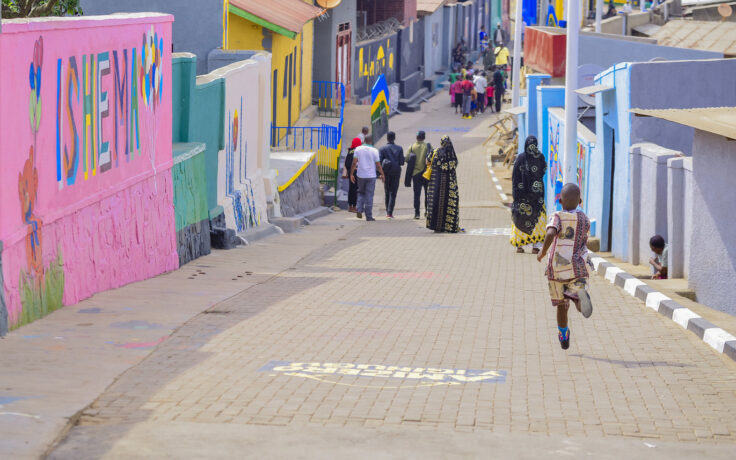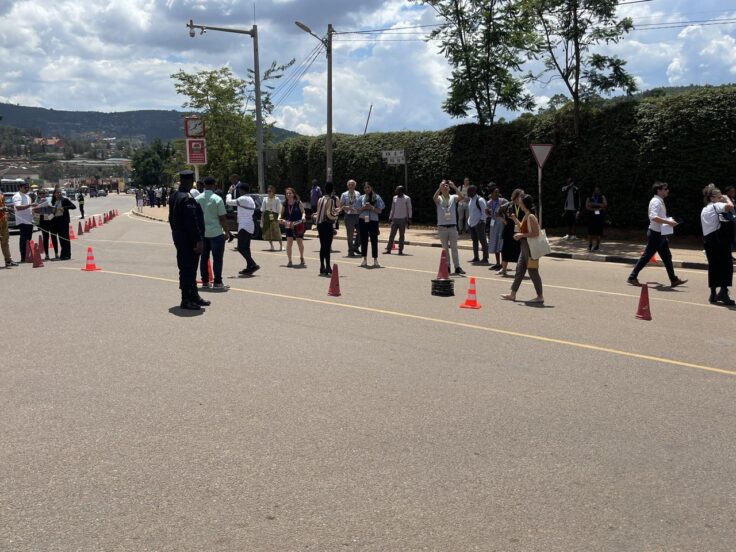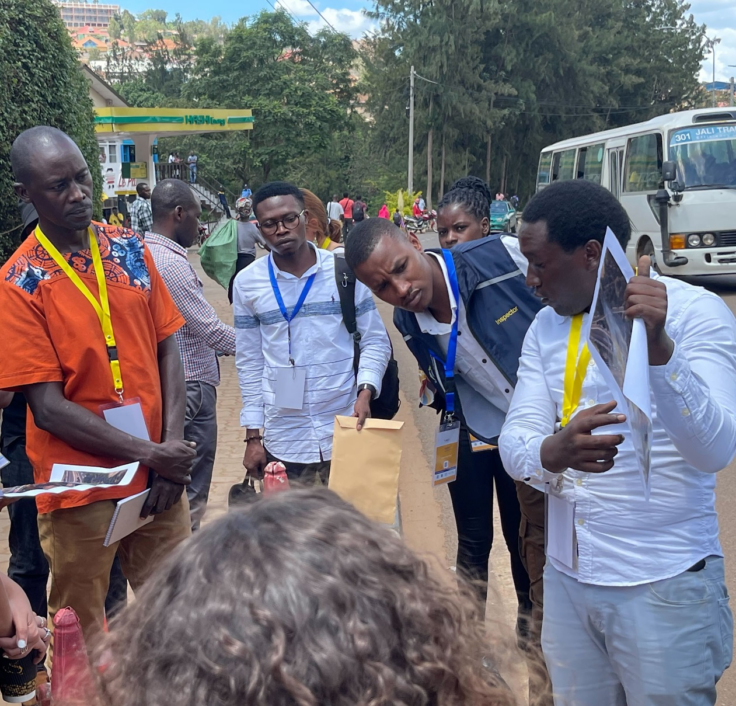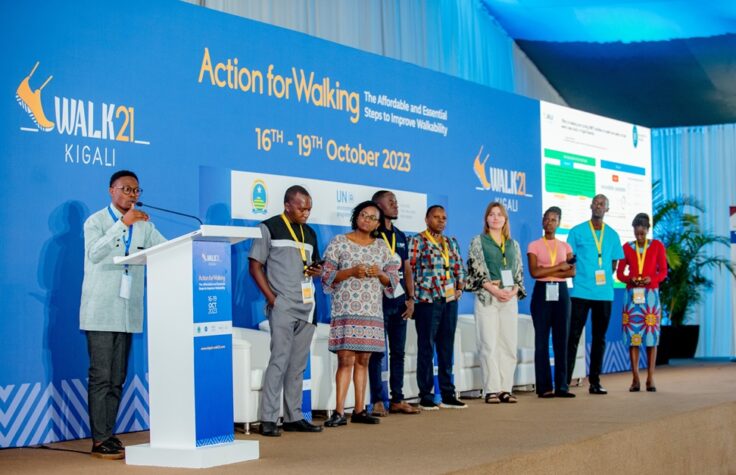November 02, 2023
The Right to Walk: Insights from Walk21 Kigali
Walk21 advocates for improvements to walking-related policy and infrastructure to ensure that walking is measured, valued, and prioritized by governments and stakeholders around the world. The 2023 Walk21 Conference convened in Kigali, Rwanda this October.
For most of the population, walking is the most fundamental and earliest form of mobility. It is inexpensive, emissions-free, offers key health-benefits, and is accessible for almost all — except those with impaired mobility — regardless of income, race, age, or gender. According to the World Health Organization (WHO), while walking provides health, transport, and environmental impacts, at the same time, street and road infrastructure in most parts of the world remain unfit for the daily activities of pedestrians. The WHO also reports that, on average, more than half of all road traffic deaths globally are among vulnerable road users like pedestrians and cyclists, and the threat is only getting worse — in the United States alone, pedestrian deaths reached a 40-year high in 2022. Per kilometer traveled, pedestrians face a nine times higher risk of death than car occupants. The proportion of pedestrians killed compared with other types of road users is highest in the African region based on WHO data, with many more injuries and accidents also under-reported. Given that nearly 80% of Africa’s population commutes by foot or bicycle every day, there is a critical need to address the harmful urban policies and systems that perpetuate this cycle.

Following the COVID-19 pandemic, there has been a notable increase in the number of people walking and cycling in Africa and all around the world. However, despite instances of progress, a recent UNEP report found that only 19 African countries (35%) have walking- and cycling-specific policies, with overall urban development still very much oriented towards motor vehicles. For a more sustainable and equitable future for Africa, there needs to be more attention, investment, and political awareness of the challenges to — and solutions for — improving walkability. The Walk21 Conference aimed to address these challenges and related issues by convening global stakeholders, including representatives from ITDP, in the Rwandan capital of Kigali to put an important spotlight on the theme of Action for Walking – Affordable and Essential Steps to Improve Walkability.
Kigali itself is leading a small but growing number of African cities that are focusing more and more on designing streets that provide adequate space for pedestrians and non-motorized transport modes. It is essential that more cities embrace people-oriented development policies that address ongoing issues of road safety, inequality in access, and rising vehicle emissions. Safer pedestrian infrastructure is a key component of the solution that can also propel economic growth, tourism, and overall livability. This year’s Walk21 centered on several key topics for walkability — improving road safety; planning for walking in low-income neighborhoods; building walking policy actions to reach sustainable development and climate goals; and financing and governance models for supporting walking infrastructure.

During Walk21, ITDP representatives and participants had the opportunity to experience first-hand the ways in which investments in non-motorized transport and supportive facilities has improved the physical and social fabric of Kigali. According to city officials, the population in Kigali has tripled over the last few years and, with ongoing population growth, ensuring sustainable and inclusive mobility is a significant issue. The Kigali Master Plan 2050 seeks to address the challenges brought by rapid urbanization by renewing the focus on walkability as a means to access essential jobs and services, in connection with public transport, micromobility, and non-motorized modes. The plan also includes considerations for enhancing the city’s street networks, improving public services and sanitation, and reshaping urban spaces to promote more density and mixed-use districts. In addition, ITDP is collaborating with the city on the preparation of a Kigali Non-Motorized Transport Master Plan to develop safer and more efficient networks for walking and cycling.
Other major cities in Africa in which ITDP works — including Nairobi, Kenya; Addis Ababa, Ethiopia; Cairo, Egypt; and Dar es Salaam, Tanzania — have also begun leading the way in building and refining strategies that spotlight quality pedestrian infrastructure. During Walk21, ITDP Africa had the opportunity to present on such efforts during a plenary session, showcasing a range of projects focused on accessible street designs, non-motorized infrastructure, and public transport. Gashaw Aberra presented on the Safer Streets Design Manual for African Cities, with which ITDP is working in different countries across the region to revise existing street design manuals. The presentation highlighted the importance of Urban Street Design Manuals that help improve walking and cycling and are crucial for addressing road safety challenges and shifting from vehicle-oriented street development. The presentation further emphasized the need to invest in rapid transit systems, such as BRT, that integrate well with walking and cycling infrastructure to create more compact, accessible neighborhoods and transport hubs. There was also a spotlight on the role of national and city governments in allocating proper funding and resources to create design standards and policies tailored to regional needs.
ITDP Africa’s Benjamin Hategekimana demonstrating street interventions (left) and Gashaw Aberra presenting during Walk21 (right).


ITDP teams and partners at Walk21 aimed to make the case for walkability as a basic human right, advocating for mobility policies and plans that serve all diverse populations, not just those with access to vehicles. Iwona Alfred from ITDP Global presented on issues of road safety as it relates to the needs of children, caregivers, and families — drawing on ITDP’s Access for All research — and emphasized the importance of child-oriented transport planning. Benjamin Hategekimana from ITDP Africa led a tactical urbanism tour and intervention in Kigali’s Kinamba intersection, one of the busiest in the city, to demonstrate the potential of low-cost and neighborhood-scale interventions to improve walkability. In another presentation, Aangi Shah from ITDP India discussed partnerships with policymakers, community groups, and civil society actors to build consensus around walking and active mobility. Aangi presented ITDP’s work on the India Freedom2WalkCycleRun program, which has engaged more than 100 Indian cities in reshaping streets with a focus on health, access, and inclusion — a model that she asserted can be replicated on both small- and large-scales worldwide.
“It was fantastic to hear that after just a year and half of India’s Feedom2WalkCyleRun campaign, we have leaders sharing that they have built a habit of cycling or walking to work, helping many of them feel healthier and more energetic. Many have also said that they now understand the infrastructure gaps on their streets much better than before.” — Aangi Shah, ITDP India
The experiences of those with limited mobility or disabilities was also given an important stage — popular Kenyan Senator and disability rights advocate Crystal Asige addressed the urgent need to include the voices and perspectives of persons with disabilities, particularly as the impacts of climate change exacerbates mobility issues for the most vulnerable communities. As ITDP has sought to promote through resources like Pedestrians First — a set of tools that measure urban walkability around the world — a future of more sustainable, equitable cities everywhere requires a reshaping of current approaches to urban planning, land use, transport design, and social policy. Only through meaningful collaboration can governments and their communities create environments that are truly safe, convenient, and enjoyable for all types of people, regardless of income, age, ability, or gender.

The projects, policies, and ideas addressed at Walk21 make it clear that decisionmakers, funders, and planners — in Africa and all around the world — need to recognize that solutions do exist, and that a future of more walkable and accessible cities is possible.
